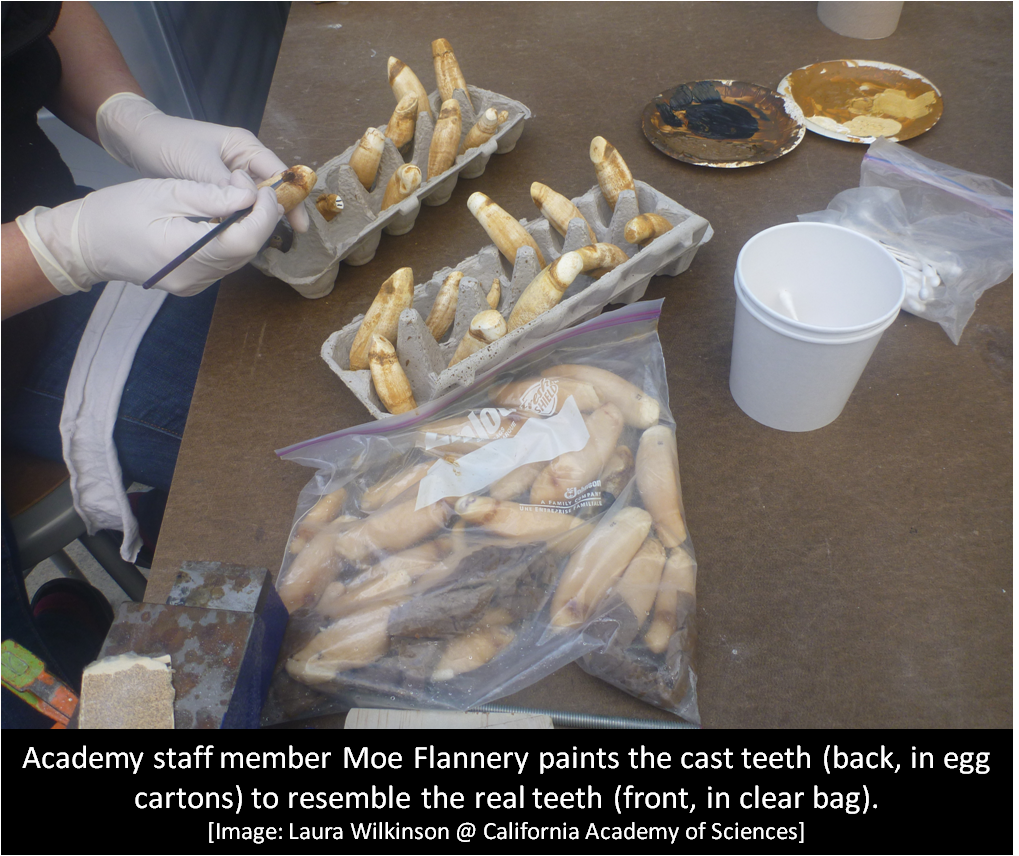Orca O319 recently received a new set of teeth made out of polyurethane! Instead of remaining on display with the rest of the skeleton, the real set of teeth from O319 will be kept in the Ornithology and Mammalogy collection to be available for researchers. Teeth of the offshore Orca ecotype are of special interest due to the wear that occurs from eating sharks with rough dermal denticles. Although O319 was still a juvenile, his teeth were worn down almost to the gum line. Researchers are not sure how this affects the long term eating habits of offshore Orcas so having the teeth accessible in our collection will aid in the California Academy of Sciences’ goals of exploring, explaining and sustaining life and increasing public education of these vital topics. Every year the Academy has a fundraising event for these conservation and sustainability programs called the Big Bang Gala. A few of our Big Bang Gala donors were able to participate in the Orca articulation process and mold and cast some of these teeth that will become part of our Orca skeleton.
Step one was to create a mold of the original set of teeth. Each tooth  was placed into a paper cup, held to the bottom of each cup with clay. Silicone was poured around each tooth and left to set overnight.
was placed into a paper cup, held to the bottom of each cup with clay. Silicone was poured around each tooth and left to set overnight.
After 24 hours the silicone had cured. The paper cups were cut away  from the silicone molds and the clay holding each tooth was removed, exposing the base of the tooth. A careful incision along the edge of the mold helped us to extract the tooth easily and we were left with a precise mold of each tooth.
from the silicone molds and the clay holding each tooth was removed, exposing the base of the tooth. A careful incision along the edge of the mold helped us to extract the tooth easily and we were left with a precise mold of each tooth.
Next, polyurethane was poured into the mold and left to dry for 30  minutes. The casts were then removed from each mold.
minutes. The casts were then removed from each mold.
Orca O319 has 47 teeth, and each was numbered and labeled so researchers know where each tooth was located in the jaw.
 After a fun day of hard work from our dedicated volunteers, all of the teeth have been cast. The bases to each tooth (the space in the mold where the clay held each tooth) was ground away so that the teeth will fit back into the skull correctly. We are currently painting the casts with oil paints to resemble the real teeth.
After a fun day of hard work from our dedicated volunteers, all of the teeth have been cast. The bases to each tooth (the space in the mold where the clay held each tooth) was ground away so that the teeth will fit back into the skull correctly. We are currently painting the casts with oil paints to resemble the real teeth.
Once we're done painting, the teeth will be glued into the Orca skull to complete our skeleton!
-Codie Otte, Curatorial Assistant and Specimen Preparator, Ornithology and Mammalogy
All marine mammal stranding activities were conducted under authorization by the National Marine Fisheries Service through a Stranding Agreement issued to the California Academy of Sciences and MMPA/ESA Permit No. 932-1905/MA-009526.


